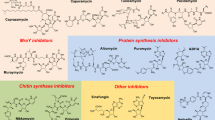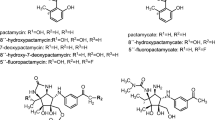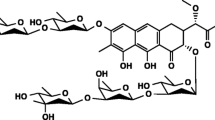Abstract
Tautomycetin (TMC) is a natural product with a linear structure that includes an ester bond connecting a dialkylmaleic moiety to a type I polyketide chain. Although TMC was originally identified as an antifungal antibiotic in the late 1980s, follow-up studies revealed its novel immunosuppressant activity. Specifically, TMC exhibited a mechanistically unique immunosuppressant activity about 100 times higher than that of cyclosporine A, a widely used immunosuppressant drug. Interestingly, a structurally close relative, tautomycin (TTM), was reported to not possess TMC-like immunosuppressant activity, suggesting that a distinctive polyketide moiety of TMC plays a critical role in immunosuppressant activity. Cloning and engineering of a TMC polyketide biosynthetic gene cluster generated several derivatives showing different biological activities. TMC was also found to be biosynthesized as a linear structure without forming a lactone ring, unlike the most polyketide-based compounds, implying the presence of a unique polyketide thioesterase in the cluster. Although TMC biosynthesis was limited due to its tight regulation by two pathway-specific regulatory genes located in the cluster, its production was significantly stimulated through homologous and heterologous expression of its entire biosynthetic gene cluster using a Streptomyces artificial chromosome vector system. In this mini-review, we summarize recent advances in the biosynthesis, regulation, and pathway engineering of a linear polyketide, TMC, in Streptomyces sp. CK4412.




Similar content being viewed by others
References
Adler JT, Cook M, Luo Y, Pitt SC, Ju J, Li W, Shen B, Kunnimalaiyaan M, Chen H (2009) Tautomycetin and tautomycin suppress the growth of medullary thyroid cancer cells via inhibition of glycogen synthase kinase-3beta. Mol Cancer Ther 8(4):914–920
Chae WJ, Choi JM, Yang JJ, Lee SK (2004) T Cell-specific immunosuppression using tautomycetin or PTD-conjugated protein drugs. Yonsei Med J 45(6):978–990
Chen X, Zheng Y, Shen Y (2007) Natural products with maleic anhydride structure nonadrides, tautomycin, chaetomellic anhydride, and other compounds. Chem Rev 107(5):1777–1830
Chen X, Zhu X, Ding Y, Shen Y (2011) Antifungal activity of tautomycin and related compounds against Sclerotinia sclerotiorum. J Antibiot (Tokyo) 64(8):563–569
Cheng X, Kihara T, Kusakabe H, Magae J, Kobayashi Y, Fang R, Ni Z, Shen Y, Ko K, Yamaguchi I, Isono K (1987) A new antibiotic, tautomycin. J Antibiot (Tokyo) 40:907–909
Cheng XC, Kihara T, Ying X, Uramoto M, Osada H, Kusakabe H, Wang BN, Kobayashi Y, Ko K, Yamaguchi I, Shen YC, Isono K (1989) A new antibiotic, tautomycetin. J Antibiot (Tokyo) 42:141–144
Choi SS, Hur YA, Sherman DH, Kim ES (2007) Isolation of the biosynthetic gene cluster for tautomycetin, a linear polyketide T cell-specific immunomodulator from Streptomyces sp. CK4412. Microbiology 153(4):1095–1102
Chung J, Kuo CJ, Crabtree GR, Blenis J (1992) Rapamycin-FKBP specifically blocks growth-dependent activation of and signaling by the 70 kd S6 protein kinases. Cell 69(7):1227–1236
Gerber DA, Bonham CA, Thomson AW (1998) Immunosuppressive agents: recent developments in molecular action and clinical application. Transplant Proc 30(4):1573–1579
Han DJ, Jeong YL, Wee YM, Lee AY, Lee HK, Ha JC, Lee SK, Kim SC (2003) Tautomycetin as a novel immunosuppressant in transplantation. Transplant Proc 35(1):547
Hong JC, Kahan BD (2000) Immunosuppressive agents in organ transplantation: past, present, and future. Semin Nephrol 20(2):108–125
Hur YA, Choi SS, Sherman DH, Kim ES (2008) Identification of TmcN as a pathway-specific positive regulator of tautomycetin biosynthesis in Streptomyces sp. CK4412. Microbiology 154(10):2912–2919
Ju J, Li W, Yuan Q, Peters NR, Hoffmann FM, Rajski SR, Osada H, Shen B (2009) Functional characterization of ttmM unveils new tautomycin analogs and insight into tautomycin biosynthesis and activity. Org Lett 11(7):1639–1642
Kang SH, Huang J, Lee HN, Hur YA, Cohen SN, Kim ES (2007) Interspecies DNA microarray analysis identifies WblA as a pleiotropic down-regulator of antibiotic biosynthesis in Streptomyces. J Bacteriol 189(11):4315–4319
Kennedy BK, Lamming DW (2016) The mechanistic target of rapamycin: the grand conductor of metabolism and aging. Cell Metab 23(6):990–1003
Kim DJ, Nah JH, Choi SS, Shin HS, Sherman DH, Kim ES (2012) Biological activities of an engineered tautomycetin analogue via disruption of tmcR-encoding hydroxylase in Streptomyces sp. CK4412. J Ind Microbiol Biotechnol 39(10):1563–1568
Kuo CJ, Chung J, Fiorentino DF, Flanagan WM, Blenis J, Crabtree GR (1992) Rapamycin selectively inhibits interleukin-2 activation of p70 S6 kinase. Nature 358(6381):70–73
Lee JH, Lee JS, Kim SE, Moon BS, Kim YC, Lee SK, Lee SK, Choi KY (2006) Tautomycetin inhibits growth of colorectal cancer cells through p21cip/WAF1 induction via the extracellular signal-regulated kinase pathway. Mol Cancer Ther 5(12):3222–3231
Li W, Ju J, Osada H, Shen B (2006) Utilization of the methoxymalonyl-acyl carrier protein biosynthesis locus for cloning of the tautomycin biosynthetic gene cluster from Streptomyces spiroverticillatus. J Bacteriol 188(11):4148–4152
Li W, Ju J, Rajski SR, Osada H, Shen B (2008) Characterization of the tautomycin biosynthetic gene cluster from Streptomyces spiroverticillatus unveiling new insights into dialkylmaleic anhydride and polyketide biosynthesis. J Biol Chem 283(42):28607–28617
Li W, Luo Y, Ju J, Rajski SR, Osada H, Shen B (2009) Characterization of the tautomycetin biosynthetic gene cluster from Streptomyces griseochromogenes provides new insight into dialkylmaleic anhydride biosynthesis. J Nat Prod 72(3):450–459
Liu H, Jiang H, Haltli B, Kulowski K, Muszynska E, Feng X (2009) Rapid cloning and heterologous expression of the meridamycin biosynthetic gene cluster using a versatile Escherichia coli–Streptomyces artificial chromosome vector, pSBAC. J Nat Prod 72(3):389–395
Liu J, Farmer Jr JD, Lane WS, Friedman J, Weissman I, Schreiber SL (1991) Calcineurin is a common target of cyclophilin-cyclosporin A and FKBP-FK506 complexes. Cell 66(4):807–815
Liu S, Yu Z, Yu X, Huang SX, Luo Y, Wu L, Shen W, Yang Z, Wang L, Gunawan AM, Chan RJ, Shen B, Zhang ZY (2011) SHP2 is a target of the immunosuppressant tautomycetin. Chem Biol 18(1):101–110
Luo Y, Li W, Ju J, Yuan Q, Peters NR, Hoffmann FM, Huang SX, Bugni TS, Rajski S, Osada H, Shen B (2010) Functional characterization of TtnD and TtnF, unveiling new insights into tautomycetin biosynthesis. J Am Chem Soc 132(19):6663–6671
Mitsuhashi S (2002) Structure and function of a novel PP-1 specific inhibitor, tautomycetin. Seikagaku 74(11):1348–1352
Mitsuhashi S, Shima H, Tanuma N, Matsuura N, Takekawa M, Urano T, Kataoka T, Ubukata M, Kikuchi K (2003) Usage of tautomycetin, a novel inhibitor of protein phosphatase 1 (PP1), reveals that PP1 is a positive regulator of Raf-1 in vivo. J Biol Chem 278(1):82–88
Nah JH, Choi SS, Kim DJ, Shin HS, Sherman DH, Kim ES (2012) Biosynthesis of an engineered tautomycetin analogue via disruption of tmcK-encoding terminal decarboxylase in Streptomyces CK4412. Proc Biochem 47(12):1773–1778
Nah JH, Park SH, Yoon HM, Choi SS, Lee CH, Kim ES (2012) Identification and characterization of wblA-dependent tmcT regulation during tautomycetin biosynthesis in Streptomyces sp. CK4412. Biotechnol Adv 30(1):202–209
Niu M, Sun Y, Liu B, Tang L, Qiu R (2012) Differential effects of tautomycetin and its derivatives on protein phosphatase inhibition, immunosuppressive function and antitumor activity. Korean J Physiol Pharmacol 16(2):145–151
Niu M, Sun Y, Liu X, Tang L, Qiu R (2013) Tautomycetin induces apoptosis by inactivating Akt through a PP1-independent signaling pathway in human breast cancer cells. J Pharmacol Sci 121(1):17–24
Nah HJ, Woo MW, Choi SS, Kim ES (2015) Precise cloning and tandem integration of large polyketide biosynthetic gene cluster using Streptomyces artificial chromosome system. Microb Cell Fact 14:140
Noh JH, Kim SH, Lee HN, Lee SY, Kim ES (2010) Isolation and genetic manipulation of the antibiotic down-regulatory gene, wblA ortholog for doxorubicin-producing Streptomyces strain improvement. Appl Microbiol Biotechnol 86(4):1145–1153
Park SH, Choi SS, Sherman DH, Kim ES (2009) A global positive regulator afsR2 stimulates tautomycetin production via pathway-specific regulatory gene over-expression in Streptomyces sp. CK4412. Proc. Biochem 44(11):1298–1301
Pinchot SN, Adler JT, Luo Y, Ju J, Li W, Shen B, Kunnimalaiyaan M, Chen H (2009) Tautomycin suppresses growth and neuroendocrine hormone markers in carcinoid cells through activation of the Raf-1 pathway. Am J Surg 197(3):313–319
Scaglione JB, Akey DL, Sullivan R, Kittendorf JD, Rath CM, Kim ES, Smith JL, Sherman DH (2010) Biochemical and structural characterization of the tautomycetin thioesterase: analysis of a stereoselective polyketide hydrolase. Angew Chem Int Ed Engl 49(33):5726–5730
Shim JH, Lee HK, Chang EJ, Chae WJ, Han JH, Han DJ, Morio T, Yang JJ, Bothwell A, Lee SK (2002) Immunosuppressive effects of tautomycetin in vivo and in vitro via T cell-specific apoptosis induction. Proc Natl Acad Sci U S A 99(16):10617–10622
Tripathi A, Choi SS, Sherman DH, Kim ES (2016) Thioesterase domain swapping of a linear polyketide tautomycetin with a macrocyclic polyketide pikromycin in Streptomyces sp. CK4412. J Ind Microbiol Biotechnol 43(8):1189–1193
Ubukata M, Cheng X, Uzawa J, Isono K (1995) Biosynthesis of the dialkylmaleic anhydride-containing antibiotics, tautomycin and tautomycetin. J Chem Soc Perkin Trans 1:2399–2404
Wang F, Kong R, Liu B, Zhao J, Qiu R, Tang L (2012) Functional characterization of the genes tauO, tauK, and tauI in the biosynthesis of tautomycetin. J Microbiol 50(5):770–776
Wee YM, Choi MY, Kang CH, Kim YH, Kim JH, Lee SK, Yu SY, Kim SC, Han DJ (2010) The synergistic effect of tautomycetin on cyclosporine A-mediated immunosuppression in a rodent islet allograft model. Mol Med 16(7–8):298–306
Yang D, Li W, Huang SX, Shen B (2012) Functional characterization of ttnI completing the tailoring steps for tautomycetin biosynthesis in Streptomyces griseochromogenes. Org Lett 14(5):1302–1305
Acknowledgments
This research was supported by the National Research Foundation of Korea (NRF-2014R1A2A1A11052236 and NRF-2015R1D1A4A01019447: S.-S. Choi), Ministry of Science, ICT and Future Planning (C1 Gas Refinery Program 2016M3D3A1A01913245), and Rural Development Administration (Cooperative Research Program for Agriculture Science and Technology Development PJ01129601).
Author information
Authors and Affiliations
Corresponding author
Electronic supplementary material
Below is the link to the electronic supplementary material.
Rights and permissions
About this article
Cite this article
Choi, SS., Nah, HJ., Pyeon, Hr. et al. Biosynthesis, regulation, and engineering of a linear polyketide tautomycetin: a novel immunosuppressant in Streptomyces sp. CK4412. J Ind Microbiol Biotechnol 44, 555–561 (2017). https://doi.org/10.1007/s10295-016-1847-2
Received:
Accepted:
Published:
Issue Date:
DOI: https://doi.org/10.1007/s10295-016-1847-2




